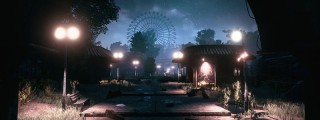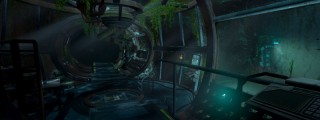With the number of horror fans we have on staff it’s no surprise that we took interest when indie developer Nathaniel Nelson reached out to us. Nelson has chosen a lofty project for his Steam debut, a visual novel adaptation of HP Lovecraft’s The Whisperer in Darkness. We asked about his experiences putting the game together, an impressive feat at the ripe old age of 17.
Let’s start with a brief overview of the game. Tell us about The Whisperer in Darkness and what you hope to achieve with it.
The Whisperer in Darkness is a visual novel based on one of H.P. Lovecraft’s horror stories. We took on the style of a visual novel to revive the spirit of Lovecraft’s writing: a subtle anxiety the next morning more than a visceral terror felt in the moment. It’s driven primarily by written dialogue, haunting visuals, and an unsettling soundtrack.
We designed and developed it in 7 days for the 2014 Public Domain Jam, then decided it deserved a shot at being a real game. Now, as the team lead and sole programmer, I’m writing the game from the ground up, and it’s taking months longer. I want to get the game in the hands of everyone who could possibly enjoy it, which means releasing on Mac, Linux, and Windows PCs with official translations to foreign languages and features to make it accessible to players with disabilities.
In regards to Lovecraft, what made you land on The Whisperer in Darkness specifically? Are there any other Lovecraft works you enjoy?
I first encountered Lovecraft about five years ago when my dad bought an eBook of his complete works. After starting at page one with “The Beast in the Cave” which we all found a bit cheesy, he flipped to a random story closer to the center of the compilation. It was “The Whisperer in Darkness,” and he read it aloud to the family. I was maybe 12 years old at the time and it spooked me terribly. I stopped listening before the end, and didn’t find the courage to finish the story for at least a month after that. I absolutely loved it.
The story became a family favorite. We read it to rapt audiences on camping trips. While I have dabbled in Lovecraft’s other stories, this one remains my favorite.
While working on my adaptation, I’ve also read a few Lovecraft-inspired works from other authors. Most notably, Alan Moore’s comics The Courtyard and Neonomicon, the former of which I enjoyed thoroughly and the latter of which scarred me for life. Let’s not talk about Neonomicon.
Tell us a little bit more about yourself and your team. Your background in game design. How many people are working on this game and how did you all come together?
I mentioned I’m only 17. I learned programming from a really young age by reading books and online tutorials. When I first took a programming class in middle school, I sped through the curriculum and ended up with a lot of time to study whatever I wanted. I wrote little text adventures for a while before I discovered Microsoft XNA. Then I got hooked on making graphical computer games, and I’ve stuck with it ever since.
About a year and a half ago, my brother told me an artist from his class wanted to work on video games. I took a look at her work online, and in one of my least intelligent moments, I almost passed on the opportunity. Her work, while incredible, mainly consisted of paintings. At the time I was more interested in making systems-focused games that would require a more gamey art style and detailed animations. Her work didn’t seem like a good fit.
I kept the thought at the back of my mind, though, and soon enough I had a eureka moment. I wanted to do the Public Domain Jam, and hadn’t settled on my source material. It occurred to me to make my game design a better fit for Quincy’s art, and make a visual novel. Lovecraft’s work is public domain, and the more I thought about it, the more I wanted to recreate my favorite horror story in a game. I met with Quincy—also a Lovecraft fan—and we agreed to do the jam together.
We knew the project would be much stronger with the help of a sound designer. Quincy started pitching the game to her friends while I searched for possible collaborators on the internet. In a stroke of great luck, I found Mark Sparling on Reddit. He shared an interest to /r/gameaweek in working as a composer on short seven-day projects, precisely like the one we were planning. I sent him an email and he came aboard.
For the game jam, our team was just the three of us: two high-school students and a freelance composer. I’m still amazed we were able to pull through with the amount of content we did in such a short time. Since we started building the game into a finished product, we’ve added two new members to the team: Marc Tamarit, a college student in Spain who’s translating the game to Spanish, and Connor Johnson, another school friend who performs at local theaters and agreed to voice the audio narration we’re including to let players with visual impairments enjoy the game.
What (if any) changes and improvements can be expected on the title before it’s released on Steam?
Our vision for the Steam version is an updated, polished and accessible recreation what we released from the game jam. I’m going over all the writing to make sure it still reflects my best work. Quincy will be fixing little flaws in the art and producing a few new pieces to flesh out the scenes where we felt rushed before.
One of the most experimental aspects of the game is our mixture of Quincy’s digital paintings with ASCII-style art. I’ve thought a lot about the effect this has on the game, and decided I won’t be removing ASCII art from the updated version. While it originated out of necessity—with so few asset creators on the team and so little time, I had to supplement Quincy’s work with my own—I feel the ASCII art is a unique part of the game and lends itself to the archaic feeling Lovecraft evokes so well. I’ll still be extensively revisiting all of it in the hopes of reducing the gap in quality between the ASCII and painted art.
Beyond those improvements, we want to release the game in more foreign languages so it can be enjoyed by international Lovecraft fans. In such a dialogue-heavy game, every translation needs to be top-notch, so we’re only including Spanish in our initial release.
The game’s dialogue will also be fully voiced in English as an optional feature for the benefit of those with blindness or other visual impairments.
What other visual novels (if any) do you enjoy? Are there any specifically that influenced your design of this game? Are there any other influences from other genres?
I didn’t actually play visual novels until long after starting The Whisperer in Darkness. In fact I still don’t, though my taste has broadened to include Twine games and other interactive fiction. The design mostly emerged as a solution to a design problem: Make the best game possible using only a programmer who can write, and an excellent visual artist. I was really just making what I could, and I struggled for a very long time to describe my game effectively. I felt wrong calling it a horror game because it’s more silent movie than game. I felt wrong calling it a visual novel because the art style is highly unconventional for visual novels and it has short interactive segments. The best label might be “walking simulator,” in all honesty. In the early days, I referred to our game as an “interactive tale of cosmic horror.” It turns out, no one knows what that means, so now I just say “visual novel.”
I can definitely list traditional horror games as an influence on The Whisperer in Darkness. I love how Amnesia: The Dark Descent uses shadow to make simple movement terrifying. Slender is one of the best ways to spend a Fall evening home alone.
Maybe the closest inspiration (though I can only identify it in retrospect) is Home. I don’t know how many people have played it, but it’s a pixelated choose-your-own horror game I totally adored. You explore the terrifically atmospheric setting while the story unravels through text and simple choices. The big similarity to our game is in the way Home builds so much stress while the player walks through totally harmless spaces. There’s no health bar or actual threat to the player’s safety (that I remember) but the experience never stops feeling frightful. I wasn’t thinking about Home while I designed The Whisperer in Darkness, but looking back it’s difficult to deny a connection between the two.
What does the future hold for you? Any upcoming projects? Long term support plans for this game, etc.?
I have to admit I’m dying to finish this game. It’s been a long, challenging project and while I love it deeply, I can’t wait to spend a few months indulging every tiny experiment I can think of. I’m going to work in Twine, PuzzleScript, PICO-8 and learn to compose music with trackers. Everything I can do to get away from C++ for a while.
That’s all going to overlap with support for The Whisperer in Darkness. I’d love to hire more translators and continue releasing language patches for the game. I’m even toying with the idea of a tablet port.
In more general terms, I’ve applied as an undergraduate to the University of Utah and plan to study many different disciplines there after I graduate high school this year: computer science, business, psychology and creative writing are just a few possibilities. I want to become versatile enough to spend my whole life making video games independently.
As for my next big game, I want to make the biggest departure possible from The Whisperer in Darkness. I’m infatuated with an idea. I just beat Spelunky for the first time, and now I’m addicted to Downwell, also a phenomenal platformer roguelike. I’m going to make a roguelike of my own, combining random levels and permadeath with the physics puzzle ball-tossing mechanics of Trick Shot, another recent favorite. I know it sounds terrible, but trust me on this one.
If The Whisperer in Darkness sounds like it might be your cup of tea, you should absolutely go support the game on Steam Greenlight by clicking here or on the icon below.![]()










